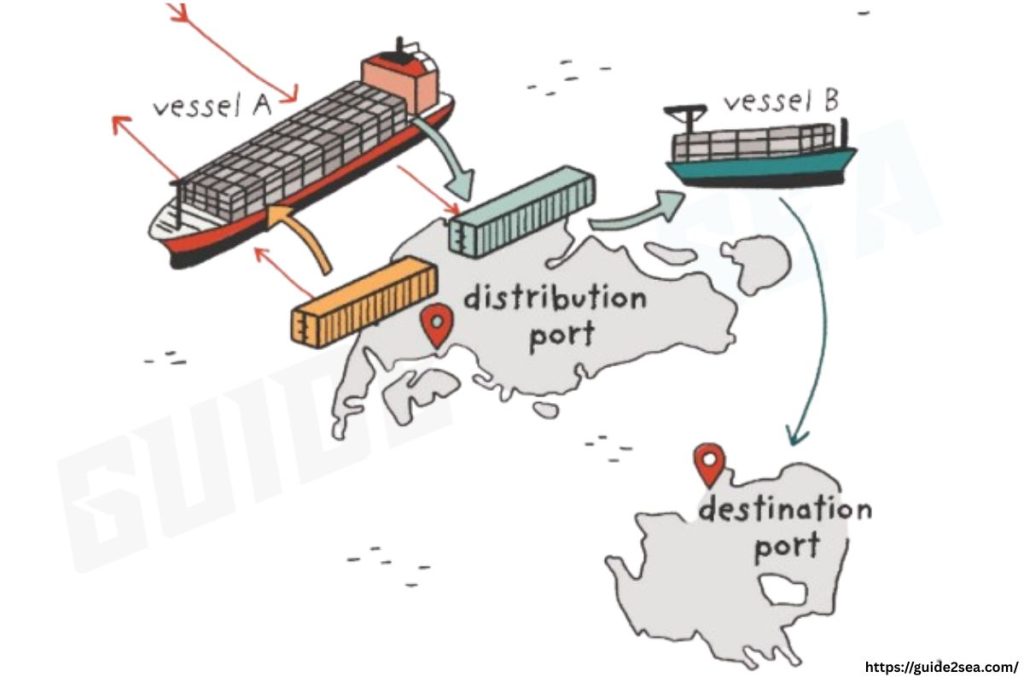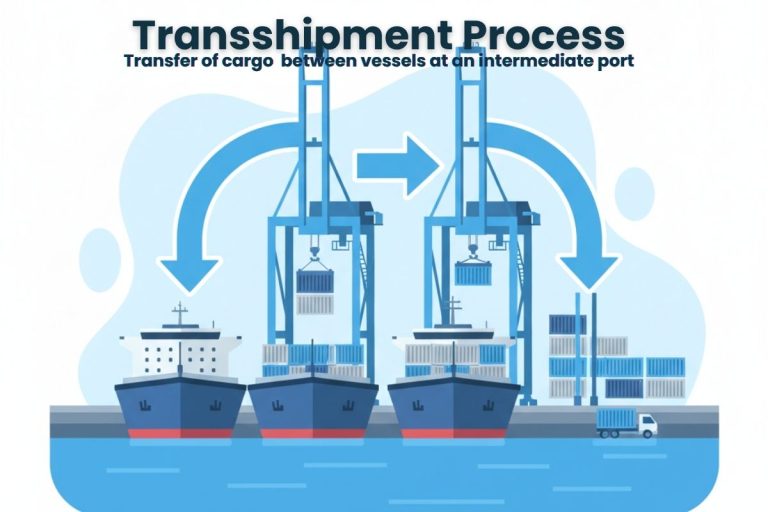Say you are planning a trip from London to Sri Lanka. Instead of taking a direct flight, you choose to travel with two flights. First, you fly from London Heathrow to Dubai. Then, from Dubai, you take another flight to Sri Lanka. This idea of changing flights is similar to what happens in shipping when goods are moved from one ship to another at a port. In shipping, this is called transshipment.
Transshipment is one of the most important operations in maritime logistics. It refers to the transfer of cargo from one vessel to another at an intermediate port before it reaches the final port of destination. This article will explore the meaning of transshipment, how it works, why it is important, the advantages, the challenges, and the future of transshipment in shipping.
Meaning of Transshipment
In simple words, transshipment means transferring cargo from one ship to another at an intermediate port on the way to its final destination. It usually takes place at hub ports. They are large, well-equipped ports that serve as central connection points in global trade.
This process is especially common in container shipping. Large ships, often called “megaships,” carry containers between major hub ports. These hubs handle huge container volumes and link smaller ports to the major international shipping routes.
Imagine a container leaving from a small port in Africa that does not have direct services to the United States. Instead, the container is first shipped to Singapore, where it is reloaded onto another vessel sailing to the United States. That stop in Singapore is a transshipment.
Why Transshipment Happens
Transshipment happens for many reasons. At a transshipment port, cargo often transfers from one ship to another instead of sending it directly from the origin to the final destination. There are several reasons for this:
1. Cost Savings
One of the main reasons shipping companies use transshipment is to save money. Shipping companies avoid sending large ships to every small port because it is expensive, especially when the ships are not fully loaded. By using a hub-and-spoke system, large vessels travel only between major hub ports. Then smaller feeder ships deliver cargo to nearby ports. This reduces fuel costs, labor, and operating expenses while maximizing efficiency.
2. Not All Ports Are Directly Connected
Many ports do not have direct connections to every other port in the world. Some small or remote ports do not have direct sea, air, or land connections to major trade hubs. Transshipment allows cargo to reach these ports through larger hub ports.
3. Challenges with Large Vessels
Modern container ships, especially ultra-large vessels, can carry thousands of containers. Not all ports can handle these huge ships due to limitations like shallow waters, short berths, or inadequate cranes. Transshipment ensures that even ports that cannot handle mega-ships can still receive cargo efficiently.
4. Political or Legal Restrictions
Sometimes, cargo cannot go directly to its final destination. Because some countries have political issues, trade restrictions, or legal regulations. Transshipment allows goods to move through neutral or allowed ports, avoiding these restrictions. This ensures that trade can continue even in complex political situations.
5. War or Conflict
Some countries are directly affected by the war situations. In this case direct shipping may be unsafe or impossible. Cargo has to be rerouted through transshipment. This protects goods and keeps supply chains running even in dangerous areas.
6. Global Connectivity
Transshipment enables global trade networks. It allows cargo from smaller ports to reach markets worldwide. For example, if there is no direct shipping line from Colombo to Los Angeles, cargo can be sent via Singapore or Dubai. This ensures that even remote ports can participate in international trade.
7. Supply Chain Efficiency
Transshipment helps shipping companies plan better schedules, reduce delays, and manage large volumes of cargo. Hub ports consolidate cargo from multiple ships, sort it by destination, and load it onto connecting vessels. This reduces confusion, improves delivery times, and ensures goods reach customers reliably.
By facilitating the movement of cargo between ships, transshipment plays a critical role in global trade, enabling goods to reach their destinations efficiently and effectively.
How the Transshipment Process Works
The process of transshipment involves several steps. Here’s a detailed overview of how transshipment works.

- Arrival of Cargo Ship: A cargo ship arrives at the transshipment port or terminal.
- Unloading: Cranes, forklifts, or other terminal equipment unload the cargo from the original ship and place it in a container yard or storage area or move it directly to the next ship.
- Temporary Storage: Containers may remain in the yard until the next ship is ready. Storage times can take from a few hours to several days.
- Customs Clearance: At some ports, customs checks may be carried out. Especially if the cargo is high-risk. This involves submitting required documents, paying duties or taxes, and complying with relevant regulations.
- Reloading: Containers are loaded onto the next ship to continue the journey toward the final port.
The steps may look simple. But this is a process that requires good coordination between shipping companies, port authorities, and logistics providers.
Major Transshipment Ports in the World
In port and logistics, some ports have developed into global transshipment hubs. It is because of their geographical location and facilities.
- Port of Singapore—The largest transshipment port in the world is Singapore. It connects to 600 ports globally. The port handles a significant amount of the world’s containers.
- Port of Colombo, Sri Lanka—The port of Colombo is the most important transshipment hub in South Asia. The geographical location of the port connects the routes between Asia, the Middle East, and Europe.
- Port of Rotterdam, Netherlands—The port of Rotterdam is the busiest port in Europe. It is a major gateway for containerized cargo. The port handles over 400 million tonnes of cargo every year
These ports have succeeded in transshipments because they are strategically located, have deep waters, advanced facilities, and excellent connectivity to other feeder ports.
The Future of Transshipment in Shipping
Several factors shape the future of transshipment in shipping. It includes technological advancements, changing trade patterns, and regulatory requirements.
- Use of Technology—The transshipment industry increasingly uses digital technologies such as blockchain, artificial intelligence, and the Internet of Things (IoT). These technologies can improve efficiency, reduce costs, and enhance transparency.
- Megaships—Shipping companies are investing in ultra-large ships that can carry over 20,000 TEUs. When larger vessels enter service, transshipment hubs will become even more important.
- Port Modernization—Modern ports are investing in automation, AI, and digital platforms to handle transshipment faster and safer. Today, several ports around the world operate as fully automated or semi-automated ports.
- Green Shipping—By today many ports follow the green port concept. It aims to reduce environmental impact by using cleaner fuels and energy-efficient operations.
- Increased Competition—Ports and terminals compete for cargo. Because of that, many countries build new ports with advanced technology and modern infrastructure to handle future trade demands. These investments in ports will lead the transshipment industry to become increasingly competitive.
Final Thought
Transshipment is an important part of global shipping and trade. It allows cargo to move across the world, even when direct services are not available. By connecting hub ports with smaller feeder ports, transshipment makes the global supply chain more efficient and cost-effective.
Without transshipment, world trade would isolate many countries, rising costs would burden businesses, and global supply chains would slow down. Despite challenges such as delays, environmental impact, and regulatory issues, transshipment remains essential for international commerce.



